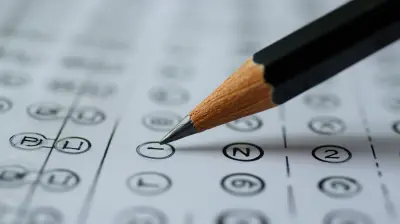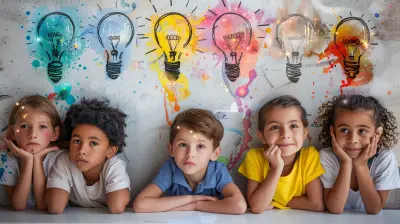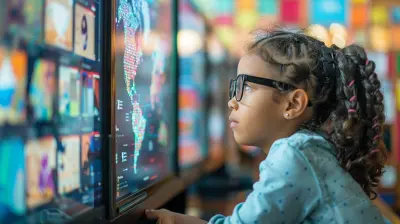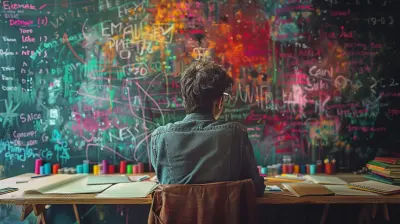How to Foster Critical Thinking in Elementary Students
9 January 2025
Critical thinking is one of the most valuable skills we can teach our children, especially at a young age. As they navigate through elementary school, they're not just learning facts and figures—they're learning how to think. But how do we ensure that they’re not only absorbing information but also questioning it, analyzing it, and thinking deeply about it? That’s where fostering critical thinking comes in.
This article will take a deep dive into practical strategies to nurture critical thinking in elementary students. Whether you're a teacher, a parent, or someone who simply cares about the intellectual development of kids, you’ll find actionable tips that you can start using today!

What is Critical Thinking?
Before we dive into the "how," let's talk about the "what." Critical thinking is the ability to think clearly and rationally, understanding the logical connection between ideas. It’s about questioning assumptions, evaluating evidence, and making informed decisions.In simple terms, critical thinking is like being a detective of knowledge—constantly asking "why?" and "how?" instead of taking things at face value.

Why Is Critical Thinking Important for Kids?
So, why should we care about teaching critical thinking to elementary students? At its core, critical thinking helps kids:- Solve Problems: When students think critically, they can approach problems systematically and come up with creative solutions.
- Make Decisions: It encourages them to weigh their options and make choices based on evidence rather than impulse.
- Enhance Learning: When kids think deeply about what they’re learning, they retain information better and make meaningful connections across subjects.
- Prepare for the Future: In a world that’s increasingly complex, critical thinking prepares children to tackle real-world challenges.

How to Foster Critical Thinking in Elementary Students
Now that we know what critical thinking is and why it's essential, let’s get to the heart of the matter—how can we foster it in elementary students? Below are several strategies that will help encourage this crucial skill.1. Encourage Open-Ended Questions
One of the best ways to stimulate critical thinking is by asking open-ended questions. These are questions that don’t have a simple “yes” or “no” answer. They require students to think more deeply and explain their reasoning.For example, instead of asking, “Did you like the story?” you could ask, “Why do you think the main character made that decision?” or “What would you do differently if you were in their shoes?”
Open-ended questions encourage students to think beyond the obvious and explore different perspectives. They also promote dialogue, which is essential for critical thinking.
2. Incorporate Problem-Solving Activities
Critical thinking and problem-solving go hand in hand. Create opportunities for students to encounter real-world problems or puzzles that they need to solve. It could be as simple as a math problem or as complex as a group project where they need to design a solution for an environmental issue.Problem-solving activities prompt students to:
- Analyze the situation
- Brainstorm possible solutions
- Evaluate the pros and cons of each option
- Make informed decisions
In addition to developing their critical thinking skills, these activities also help kids build resilience, as they learn that not every solution works the first time.
3. Promote Group Discussions and Peer Learning
Group discussions are a fantastic way to foster critical thinking because they encourage students to share their thoughts and listen to others. When kids engage in discussions, they’re exposed to different viewpoints and are forced to reconsider their own ideas.In a group setting, students might say, “I thought this, but now that you mention it, I can see how your idea makes sense too.” This is critical thinking in action—evaluating, comparing, and synthesizing information.
To make discussions even more effective, encourage students to ask each other questions and challenge ideas respectfully. This helps them practice defending their positions with evidence, another critical thinking skill.
4. Use “Think-Aloud” Strategies
Ever considered narrating your thought process out loud? This is a fantastic way to model critical thinking for students. When you "think aloud," you demonstrate how to approach a problem or question systematically.For example, if you’re solving a math problem, you might say something like:
- “First, I need to figure out what the problem is asking.”
- “What information do I have?”
- “What are some possible solutions, and which one makes the most sense?”
When kids hear how you approach a problem step-by-step, they learn how to organize their thoughts and approach challenges logically. Eventually, they’ll start applying the same thought process to their own work.
5. Encourage Reflection
Reflection is an often-overlooked aspect of critical thinking. After completing an activity or lesson, take a few minutes to ask students how they felt about it. What did they learn? What would they do differently next time?Reflection helps students internalize their learning and deepen their understanding. It also encourages them to think critically about their own actions and decisions.
For example, after a group project, you could ask:
- “What went well during the project?”
- “What challenges did we face?”
- “How could we improve our teamwork next time?”
These reflective questions help students think critically about their experiences and learn from them.
6. Introduce Debates and Role-Playing
Debates and role-playing exercises can be a fun way to get students thinking critically. In a debate, students must take a stance on an issue and back it up with evidence. This forces them to evaluate information, build arguments, and anticipate counterarguments—all essential critical thinking skills.Role-playing can also help students think critically by putting them in someone else’s shoes. For example, if you’re studying a historical event, students could take on the roles of different historical figures and debate their points of view. It’s a fantastic way to get kids thinking about multiple perspectives.
7. Connect Learning to Real-Life Scenarios
Kids often ask, “Why do I need to learn this?” Connecting lessons to real-life scenarios is a powerful way to make learning relevant and encourage critical thinking. If students can see how what they’re learning applies to the world around them, they’ll be more motivated to think deeply about it.For instance:
- If you’re teaching math, relate it to budgeting for a vacation.
- If you’re studying science, discuss how it applies to solving real-world environmental problems.
When students see the real-world application of what they’re learning, they’re more likely to engage with the material critically.
8. Encourage Independent Research
Allowing students to explore topics on their own can be a great way to foster critical thinking. Encourage them to ask questions about things they’re curious about and to research the answers independently. This could be as simple as letting them pick a topic for a project or giving them time to explore questions that arise during lessons.Independent research helps students:
- Develop curiosity
- Analyze sources for credibility
- Draw their own conclusions
By guiding students toward independent thinking and research, you’re helping them become lifelong learners who are always curious and questioning the world around them.
9. Teach Students to Question the Information They Consume
In today’s digital age, kids are constantly bombarded with information—from social media, YouTube videos, to news articles. Teaching them to scrutinize the information they encounter is more important than ever.Encourage students to ask:
- “Who created this information?”
- “What is the purpose of this message?”
- “Is there bias in this information?”
- “What evidence supports this claim?”
By teaching students to evaluate the credibility of sources and question the information they consume, you’re equipping them with the tools they need to navigate a world full of misinformation.
10. Foster a Growth Mindset
Finally, fostering a growth mindset in students is key to developing critical thinkers. When students believe that their intelligence and abilities can grow with effort, they’re more willing to take risks, ask questions, and tackle challenges.Encourage students to see mistakes as opportunities to learn rather than failures. When they struggle with a problem, help them understand that persistence and effort are part of the process. This mindset fosters resilience, curiosity, and a willingness to engage deeply with learning—all essential components of critical thinking.

Conclusion: Building Lifelong Thinkers
Fostering critical thinking in elementary students isn’t just about teaching them to solve problems—it’s about teaching them how to approach the world with curiosity, skepticism, and a desire to understand. By encouraging open-ended questions, promoting peer discussions, modeling "think-aloud" strategies, and connecting learning to real-life scenarios, we’re helping kids build the tools they need to think critically throughout their lives.Remember, critical thinking is a skill that gets stronger the more it’s practiced. So, whether you’re at home, in the classroom, or anywhere in between, these strategies can help cultivate the next generation of thinkers, problem-solvers, and innovators.
all images in this post were generated using AI tools
Category:
Teacher ResourcesAuthor:

Olivia Chapman
Discussion
rate this article
17 comments
Lumen West
Fostering critical thinking in young minds is like planting tiny seeds of curiosity! 🌱 Let’s sprinkle in some questions, mix in a dash of creativity, and watch them bloom into thoughtful little problem solvers. Who knew learning could be so much fun? 🎉
February 7, 2025 at 4:21 AM

Olivia Chapman
Absolutely! Encouraging curiosity and creativity is key to nurturing critical thinkers. Let's keep the questions coming and make learning an enjoyable adventure! 🌟
Zephyrae McTavish
In the garden of young minds, let questions bloom, Nurture curiosity, dispel the gloom. With gentle guidance, ignite their spark, Foster thoughts that blaze, illuminating the dark. In playful discourse, wisdom shall thrive— Empowering their voices, watch young minds arrive.
January 31, 2025 at 9:58 PM

Olivia Chapman
Thank you for your beautiful poem! It perfectly encapsulates the essence of nurturing curiosity and fostering critical thinking in young minds.
Natasha McDougal
Fostering critical thinking in young learners nurtures their curiosity and confidence, empowering them to explore and understand the world.
January 28, 2025 at 12:39 PM

Olivia Chapman
Thank you for your insightful comment! Fostering critical thinking indeed cultivates curiosity and confidence, essential for lifelong learning and exploration.
Marie Barlow
This article offers practical strategies to enhance critical thinking in elementary students, emphasizing inquiry-based learning, collaborative activities, and real-world problem-solving to engage young minds effectively.
January 24, 2025 at 8:18 PM

Olivia Chapman
Thank you! I'm glad you found the strategies helpful for engaging young learners in critical thinking.
Nicole Hunter
Teaching critical thinking? Just remember: kids are natural detectives; we’re merely their quirky sidekicks!
January 21, 2025 at 3:50 AM

Olivia Chapman
Absolutely! Encouraging their natural curiosity enhances critical thinking, making the learning process both fun and effective.
Kenneth Lambert
Great insights! Encouraging critical thinking early sets a strong foundation for lifelong learning.
January 18, 2025 at 5:01 AM

Olivia Chapman
Thank you! I completely agree—encouraging critical thinking from a young age truly empowers students for future learning and growth.
Tabitha Adkins
Empowering young minds to question and explore fosters creativity and confidence—nurture their critical thinking skills today!
January 17, 2025 at 9:34 PM

Olivia Chapman
Thank you for your insightful comment! Encouraging questioning and exploration is indeed vital for developing critical thinking in young learners. Your support for nurturing these skills is greatly appreciated!
Sasha McAllister
Unlocking the minds of young learners requires more than just lessons; it’s an adventure into the unknown, where questions spark curiosity and ignite transformative insights.
January 16, 2025 at 1:53 PM

Olivia Chapman
Absolutely! Encouraging curiosity and exploration is key to fostering critical thinking in young learners. It’s about creating an environment where questions lead to discovery.
Deborah Simon
Encouraging questions and discussions enhances critical thinking in young learners.
January 15, 2025 at 1:31 PM

Olivia Chapman
Absolutely! Encouraging questions and discussions promotes deeper understanding and empowers young learners to think critically.
Ainsley Vaughn
Encouraging inquiry and discussion empowers young minds to develop essential critical thinking skills.
January 15, 2025 at 5:02 AM

Olivia Chapman
Absolutely! Encouraging inquiry not only promotes critical thinking but also inspires a lifelong love for learning in young minds.
Caelum McElveen
This article sparks my curiosity! I’m eager to explore innovative strategies for nurturing critical thinking in young learners—it's crucial for their development and future problem-solving skills.
January 14, 2025 at 11:36 AM

Olivia Chapman
I'm glad to hear that! Exploring innovative strategies is essential for nurturing critical thinking. Let’s empower our young learners together!
Yazmin Huffman
Encouraging questions over answers nurtures curiosity, shaping young minds into independent thinkers.
January 14, 2025 at 4:20 AM

Olivia Chapman
Thank you for highlighting the importance of fostering curiosity! Encouraging questions is indeed a key strategy in developing independent thinkers.
Reece McDougal
Ask questions; kids love to debate!
January 13, 2025 at 8:21 PM

Olivia Chapman
Absolutely! Encouraging questions stimulates curiosity and critical thinking in kids, making debates a fantastic way to explore ideas and develop reasoning skills.
Blake McLaurin
Great article! Fostering critical thinking in young minds is so important. Simple activities like encouraging questions and discussions can make a huge difference. Let’s empower our students to think deeper and explore the world around them!
January 11, 2025 at 5:17 AM

Olivia Chapman
Thank you! I completely agree—encouraging questions and discussions is key to nurturing critical thinking in students. Let's keep empowering their curiosity!
Heather Barnes
Wow, what a revolutionary idea! Because who would have thought that encouraging kids to think for themselves could actually make a difference? Next, let’s write an article on how to teach them to breathe. I’m sure they’ll find that equally enlightening. Can’t wait for the sequel!
January 10, 2025 at 7:34 PM

Olivia Chapman
Thank you for your feedback! Encouraging critical thinking is indeed fundamental—every little step counts in education.
Mindy McVicar
Critical thinking in kids? Just remember: if they can debate why the sky is blue and not purple, you're on the right track! 🌈
January 10, 2025 at 1:23 PM

Olivia Chapman
Absolutely! Encouraging kids to question and debate fosters their critical thinking skills, helping them explore concepts creatively and deeply. 🌟
Olive Whitley
Oh sure, because all it takes to inspire critical thinking in elementary students is a magic wand and some glitter! Who knew? Just sprinkle a little “think outside the box” pixie dust, and voilà—future Einsteins! Can’t wait to see those 7-year-olds solving world problems before recess!
January 10, 2025 at 6:04 AM

Olivia Chapman
While it may seem overly simplistic, fostering critical thinking in young students requires intentional strategies and creativity, not just magic. Engaging them in hands-on activities and real-world problem-solving can truly spark their curiosity and inspire future thinkers.
MORE POSTS

Motivating Students to Become Lifelong Learners

The Impact of First Impressions on Communication

Mastering Test Prep: Proven Strategies for Success

Helping Students Set and Achieve Personal Learning Goals

The Future of Learning Analytics in E-Learning Platforms

How Differentiated Instruction Supports Social-Emotional Learning

The Importance of Setting Clear Study Boundaries

Using Data to Drive Classroom Instruction

How E-Learning Can Support Lifelong Learning Goals

The Road to Independence: Decolonization in Africa

Overcoming Test Anxiety: Tips for Staying Calm and Focused